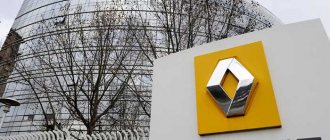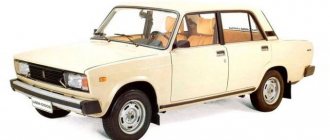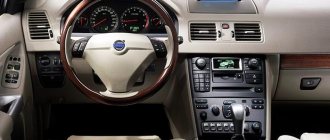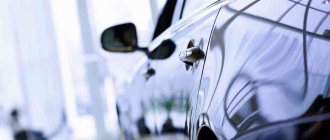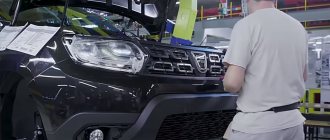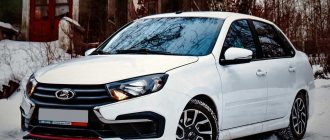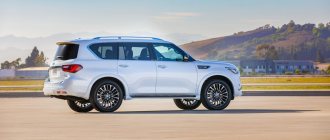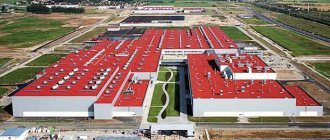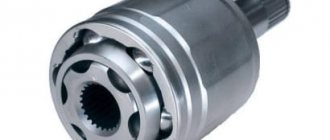Thanks to their high-quality build, the cars are among the most reliable used cars. The company has a very memorable logo consisting of four rings. The competition is two and Mercedes Benz. The feud began in 2006 with the release of a congratulatory video for Audi's victory in the South African Best Car category.
Audi car factories
There are several reasons why the concern opens branches on different continents. Many car factories allow us to produce products in large volumes and fully satisfy the needs of the market.
Branches located in close proximity to potential consumers make cars cheaper due to the absence of significant transportation costs and customs duties.
- At home in Germany there are more than two dozen Audi factories and design centers;
- The concern's largest subsidiary in the USA saturates the North American markets;
- Audi car plants in Mexico, Brazil, Argentina serve Latin American consumers;
- The Asian market receives Audi from branches in Malaysia, China and India;
- The car plant in South Africa supplies the market of this continent with all Audi models;
- For the European consumer, not only factories in Germany work, but also production enterprises in Belgium and Slovakia;
- In Russia, a branch of the Audi-Volkswagen concern was opened in Kaluga.
Initially, the company planned mass assembly of Audi in Russia. But these works had to be curtailed due to low sales and a limited number of consumers ready to buy prestigious cars. Now the Kaluga branch produces only two popular sedan models - A8 and A6. Considering that reviews about the quality of cars that roll off the assembly line of the plant in Kaluga are not the most flattering, you shouldn’t be upset about this fact. Models imported from Europe are more expensive, but their quality is higher.
This is interesting: Is it possible to refuel Solaris 92
Listen to Audi!
Audi a6 allroad quattro review: history, characteristics, features
In 1900, Horch founded the company A. Horch & Co in Mannheim and produced the first car. The conflictual nature of the “founding father” led to the fact that the genius of the automobile industry in 1909... was fired by the board of directors.
Horch did not shed tears for a long time and within a month he founded a new one. Former partners filed a lawsuit against the designer, citing the word “Horch” in the new name of the auto company as the reason for filing the lawsuit. August Horch lost the case.
And then at the family council, where the 3 sons of the high school student were present, one of them, the youngest, 10-year-old Heinrich Horch, proposed a simple solution. The German words Hören, Horchen, translated as “listen, listen” in the imperative form, “Listen” in Latin sounds like “audi!”, and in German – “horch!”, which is completely consonant with the family name.
Since then, in the Horch family, Henry has been called nothing less than Audi. So try after this to disagree with the wisdom of the Gospel: “Through the mouth of a child the truth speaks.
From Audi to Auto Union
Only 4 years passed, and new Audi cars began to win international races in the Alps. Back then they were considered the most severe test for a car. Soon Horch opened a second enterprise - his cars were in unprecedented demand.
During the First World War, the founder of the brand somewhat retired, becoming an expert in the German automobile industry. In the 20s, the Audi company was threatened with bankruptcy and in 1928 it was merged with the German automaker DKW, and Jorgen Rasmussen became the owner of the AUDI brand.
The crisis of 1932 forced a number of German automobile manufacturing firms to merge into a single concern, Auto Union. These were the following brands:
- DKW;
- Wanderer;
- Horch;
- Audi.
Today's “Four Rings” is the most famous Audi trademark - the reincarnation of the four-ring sign of the Auto Union concern, a German auto giant of the 30s.
Auto Union produced only two front-wheel drive models with Wandere engines. Before the war, they sold out like hotcakes. August Horch led the development of a new generation of luxury cars.
Auto Union cars created by Ferdinand Porsche, with outstanding drivers Bernadt Rosentajer, Tazio Nuvolarali and others, shone on the race tracks of Europe, scoring 33 victories in the Grand Prix!
Germany is divided, and the concern is divided
After the Second World War, the factories of the Auto Union concern that were located in Zwickau fell under the “hand of Moscow”, and some of the equipment was generally transported to MZMA, where the Moskvich was produced. Later, the famous Trabants cars began to be manufactured from the “remnants” of the concern in the GDR.
In the early 50s, but already in Germany, in Dusseldorf (Auto Union production facilities were also there) they began to produce DKW cars. The modern history of the brand began in 1964, when the shares of Auto Union were purchased from Daimler-Benz by the Volkswagen concern.
15 years later, the first post-war Audi model, assembled at a plant built in Bavaria (Ingolstadt), was manufactured on the basis of the DWK F102.
Bright present Audi
Today, Audi AG is the largest European concern. In the Belgian city of Ingolstadt, the A3 and A4 families are produced, in Neckarsulm - A5 and A8. In the Hungarian Gyor, the Audi TT and Audi TT Roadster are assembled and engines are produced. The Q7 is made in Bratislava, and Volkswagen is made in Sarajevo (CKD assembly of A4 and A6). In addition, subsidiaries where Audi are assembled also operate successfully in South Africa and China.
Now Audi is still the “daughter” of Volkswagen and enjoys well-deserved authority among car connoisseurs. A spectacular interior, an improved design solution, reliability and European quality - all this is embodied in the famous Audi brand, which, despite all the vicissitudes, has kept the brand name unchanged.
And if you “listened” to yourself and chose a car of this brand, you can order from our company in the original version.
Audi branch locations
In the technical documentation for Audi cars, the country of manufacture is indicated as Germany, however, the manufacturer of the product does not always have a German location. The concern's branches are located on almost all continents, which allows it to actively supply products to all countries of the world, cope with the global scale of production work, while simultaneously developing new items, strengthening its position in the market. As for production, all significant components and assemblies that predetermine the appropriate functionality of the vehicle are manufactured primarily in German factories. Branches in most cases are engaged in assembly work, which minimizes the factor of the product’s inconsistency with the global brand. The location of the assembly plants of the Audi concern is predetermined by their following geography:
- Germany, as a country producing Audi, has more than two dozen enterprises producing vehicles, as well as centers dealing directly with design and engineering issues.
- The largest complex in terms of scale and production trends is located in the USA, where Audis of almost all modifications are assembled, providing 100% of the products to the North American regions.
- Production departments in Brazil - five branches engaged in large-scale assembly, as well as plants in Argentina and Mexico, where certain Audi models are assembled - supply Latin American automotive markets with products.
- Models for African countries are produced at a plant in South Africa.
- Asian consumers have the opportunity to purchase vehicles under the Audi brand in domestic automobile markets, equipped at factories in India and Malaysia, with large-scale parts produced in China.
- In European countries, in addition to cars with an absolute German pedigree, Audi models can be supplied, completed at factories in Slovakia and Belgium.
- The Russian plant in Kaluga is engaged in large-scale assembly of some models of machines supplied to domestic markets.
Let's try to answer the current questions of domestic consumers, which Audi models are assembled in Russia, who produces cars for the Russian market that are not manufactured in Kaluga, and we will analyze how the fact of domestic intervention in the configuration of cars is reflected in the quality and operational features of the products.
Where are Audis assembled for the Russian market?
Globalization has done its job: the country of assembly and the geography of assembly shops are gradually losing their importance. In addition, almost nowhere in the world is there such a thing as the complete production of a vehicle in one plant. The production of parts is too specific, so components are manufactured in different places and then assembled together. Therefore, by default, it is not for nothing that the localization of assembly means the place where the car was assembled on the assembly line, because after this there is testing, inspection and the first launch.
In Russia the brand is loved and respected. The car is considered a prestigious and elegant vehicle, although its popularity is inferior to its competitors BMW and Mercedes. Cars for the Russian market come from different parts of the globe, since much depends on the model and modification.
Audi representatives have repeatedly stated that there is little point in looking for information about the geography of car assembly, since all components and final products go through the acceptance stage, where quality control is guaranteed. In other words, thanks to the developed standards, a car produced in China or Hungary will be no different from the same one assembled in Germany or Russia.
However, users have their own opinion: many are confident that the German assembly is better than the Russian one, and are even willing to overpay certain amounts for information on the barcodes of the constituent elements.
Warranties from the manufacturer or dependence of reliability on the location of the assembly branch
Over the many years of its existence on the market, the German manufacturer has been characterized as a responsible and reliable supplier of cars. Despite the fact that branches of the Audi plant are scattered all over the world, the Germans are meticulous about the manufacture of products at absolutely all factories; the human factor influencing the quality of products is minimized. At each enterprise of the concern, regardless of what country it is, modern, modernized equipment is installed for the production of products that meet international standards, and each car supplied for sale undergoes the strictest technological control. Even at branches in African and some Asian countries, where it would be much cheaper to use human labor, the German manufacturer refuses this option to solve the problem, preferring, despite the significant financial costs, to produce suitable, reliable and technologically advanced products.
There were precedents when a concern, in favor of supplying quality goods, refused to manufacture certain models if there were complaints from technologists about the quality of the machines produced. For example, in Russia, the Audi Q5 and Q7 models were withdrawn from production due to a decrease in demand for them due to inconsistencies in the quality of assembled cars. Statistical data and user reviews indicate that product quality does not suffer depending on which branch directly produced the Audi car, where the car was assembled, however, exceptions to the rules were still registered. This fact forces potential buyers, when selecting a vehicle, especially a premium category from the Audi concern, to figure out where this or that model is assembled.
Audi Q7 Slovak assembly is delivered to
- Russia
- EU countries
- China
Audi factories where cars are assembled for the Russian market
We remind you that in the period from 2007 to 2010, this crossover was also assembled at the plant in Kaluga (Russia). But, due to the unstable economic situation in the country, the company could not reach full production volumes of the Q7 model. Until the beginning of this year, the Q5 and A7 models were assembled at the same plant. Today the plant assembles the following models:
- Audi A8
- Audi A6
- Volkswagen Tiguan
- Volkswagen Polo
- Skoda Rapid.
To make each model body, workers use:
- 220 aluminum and steel parts
- 56 work cycles
- 3400 welding points.
After painting, all car components are sent to the assembly shop. For assembly and testing of the Audi Q7, separate installations and special equipment are used. The entire manufacturing process consists of 165 stages. After complete assembly, all cars of this model are sent to a 2.4-kilometer track for testing. In fact, where the Audi Q7 is manufactured plays an important role. Because the reliability and comfort of the vehicle completely depends on the quality of the assembly. Recently in Russia they began accepting orders for the new generation of the model (the price of the car is 3,630,000 rubles). It can be assumed that the assembly of the old Q7 was stopped due to a generation change.
Pedigree of Audi cars for the domestic market
Some time ago, at the opening of the plant in Kaluga and the start of its operation, the management of the concern planned mass production of Audi products in Russia, making it possible to almost completely meet the needs of domestic buyers, and not only. However, the plans were changed due to the low-quality execution of some of the machines: popular models from the “ku” line, versions 5 and 7, did not meet consumer expectations, so their production in Russia was discontinued. At the present time, the Audi Q5 model for Russia is supplied directly from Germany, and only the plant in Slovakia is engaged in the production of Q7 crossovers. As for the compact, popular Q3 model, consumers have no complaints about the quality of its production; they are assembled exclusively in Spain, where production has been established since 2011, workshops are equipped and the manufacturing process is organized at the highest level in accordance with modern technological requirements.
The plant in Russia currently assembles the sixth and eighth versions of the A-line sedans, popular among domestic consumers. There are not very pleasant rumors about the quality of Audi A6 cars assembled at the Kaluga plant, however, potential buyers should not immediately refuse to purchase this model. At the same time, copies of these versions of cars from Europe are supplied to the domestic market, which allows you to make a purchase “without risk”, however, the cost of imported cars will be significantly higher. Manufacturers explain this discrepancy in prices not by the quality indicators of the products, but by the increased costs of transporting machines.
A lot of discussions are taking place in Russia among consumers on the topic of where the Audi A4 is assembled, which is an interesting purchase for both “ordinary” people with the means and for premium category buyers. The fact is that back in 2013 it was planned to start large-scale assembly of these models at the Kaluga plant. These plans never became a reality, although initially German manufacturers gave the official go-ahead for the production of the A4 in Russia. This model is supplied to the domestic market directly from Germany, despite the fact that its assembly is also carried out in other branches scattered across continents. The answer to the question of where the Audi A3 is assembled for Russia is not so clear: cars of this version are produced both in Germany and Belgium, and in China, which requires checking the pedigree of the model before purchasing.
The formation of the company - the main facts from the history of Audi
The corporation began its existence in 1909, but the official year of foundation is considered to be 1899. The concern became the brainchild of four automobile manufacturers who joined forces in the fight against competitors. The founder of the corporation is considered to be the German engineer August Horch
. To create a successful concern, four German corporations joined forces - Horch, DKW, Audi and Wanderer.
At first the corporation was called Auto Union and produced cars and motorcycles under different brands, but later received the more euphonious name Audi.
Main events in the history of the company in the 20th century:
- In 1929, the corporation faces an economic crisis, a worldwide recession. At this moment, the DKW company gains control of the concern and produces an “anti-crisis” car with front-wheel drive and a small engine capacity - DKW-1
. - In 1932, the four founding companies of Auto Union united again under the leadership of the Saxon Municipal Bank and formed a new logo in the form of four united rings. This logo, with minimal changes, exists to this day.
- In 1940, against the background of the outbreak of World War II, the plant curtailed the production of passenger cars. They were replaced by a military vehicle Horch 901
, which was produced during wartime.
- After the war, the company was only able to recover in 1950, producing the first successful car, the DKW F89 P Master Class
. During wartime, the plant's facilities were removed and the buildings were destroyed. Therefore, since 1946, the corporation was created anew in the city of Ingolstadt, where the company’s production and headquarters are located to this day. - 1958 could change the course of history, as Auto Union came under the control of Daimler-Benz AG. But not the most successful car models during this period led to the sale of the corporation already in 1964 to the Volkswagen concern.
- Despite VW AG's desire to turn the capacity of the Auto Union plant into a site for the production of Beetle, the concern's management defended the right to produce cars under its own brand. The first-born of the company under the leadership of Volkswagen was the legendary Audi 100
, which gave rise to many other models of the concern. - Until 1980, Audi cars had a new, technologically advanced five-cylinder engine, Quattro all-wheel drive, and a turbocharger. This has made the brand one of the most technologically advanced in Europe.
- The Audi Group as we know it was founded in 1993. From that time on, a new history of the company began, which included a number of acquisitions, including the purchase of the Cosworth and Lamborghini brands, as well as the absorption of the Italian corporation SEAT.
The history of the Audi brand includes many interesting events, most of which influenced what kind of cars we see in the ranks of the corporation’s model line today.
Mobile Museum – history and development
The impressive history of the Audi brand, together with the history of human mobility as a whole, is presented with true realism - both informative and entertaining. Presentations using images, reconstructed scenes, and multimedia elements are arranged in numerous exhibits showcasing historical and contemporary contexts.
is open daily from 9.00 to 18.00.
You can book a tour by phone: +49 841 89-37575
opening hours :
- from Monday to Friday: from 8.00 to 20.00;
- on Saturday: from 8.00 to 16.00.
THE MUSEUM PRESENTS THE FOLLOWING TOURS:
Sightseeing tour “Mobile Museum-Compact”
Individual visitors
Dates:
- from Monday to Saturday: from 9.00 to 17.00, every hour;
- on Sunday: at 11.00, 13.00 and 15.00.
Prices:
- adults: 4 euros;
- elderly people, students, schoolchildren: 2 euros;
- children under 6 years old (with adults): free.
Groups
Languages: German, English.
Duration: 1 hour.
Group size: maximum 20 people.
Group price: 60 euros.
For the elderly, students and people with physical disabilities: 30 euros.
Mobile museum-intensive: “More than just car stories”
Languages: German, English.
Duration: 1.5 hours.
Group size: maximum 20 people.
Group price: 120 euros (excluding bus ride).
Dates: on request.
Color Change: "Car Colors and Color History"
Languages: German, English.
Duration: 1.5 hours.
Group size: maximum 20 people.
Group price: 120 euros.
Dates: on request.
Motorsport: “An incredible success story”
Languages: German, English.
Duration: 1.5 hours.
Group size: maximum 20 people.
Group price: 120 euros.
Dates: on request.
This is interesting: Where is the body number on the VAZ 2110
Advantages and disadvantages
Considering that due to the pandemic, Ingolstadt was delayed in delivering the Audi Q3 2022 to Russia (production was established in Hungary), there are no real reviews yet. Sales started only a month ago and, of course, no statistics can be collected yet.
But given the technical identity with last year's SUV, all compliments and curses can be addressed here. On a positive note:
- sporty, representative appearance;
- versatility;
- good combination of drive and price;
- excellent handling (most likely due to the VGS system);
- unpretentious soft suspension;
- relatively inexpensive maintenance (in comparison with the Q7 this is true);
- frisky box.
Not a single car is without sores and shortcomings, and the Audi Q3 2022 is no exception. Thus, the owners of the previous model are indignant at the cramped interior, which is even smaller in the Sportback, at the oil-hungry engine and short-lived support bearings.
Spacious trunk of the Audi Q3 2022 Sportback
Geographical distribution of Audi cars
The automobile companies that are part of the Volkswagen AG group are incredibly widespread throughout the world. Today it is one of the widest geographical concerns that successfully operates on almost all continents. In most cases, only large-scale assembly of machines takes place outside Germany; the main production assets are located within the European country. As for Audi cars specifically, the company offers a wide assembly geography. The largest companies outside Germany are located in North America, one of the first markets for the purchase of these cars. In general, in the world you can find companies associated with Audi in the following countries:
- Germany - more than ten factories of various fields and large research engineering centers;
- The USA is the largest assembly and production hub with its own model range and technical features;
- Brazil - five enterprises that produce large-scale assembly for all Latin American countries;
- Argentina and Mexico are two other Latin countries where some models are assembled;
- South Africa - almost the entire model range for Africa is assembled at a large plant in this country;
- India and Malaysia are Asian concerns created to reduce the cost of some production processes;
- China is a huge division of Audi that develops and produces engines, bodies and all other parts for cars in Asia;
- Slovakia and Belgium - some engineering developments for the concern are carried out in these countries.
There are also assembly facilities for Audi cars in Russia, but they are not very common. At the Volkswagen AG plant in Kaluga today they assemble the Audi A6, as well as the Audi A8 - the two most popular sedans in their class for the market in our country. In most cases, these cars are sold to businesses or politicians, so the corporation left mass assembly in our country. The remaining models, which were previously assembled in Russia, have left our conveyors and are being exported to the country from Europe. This caused a slight increase in the price of cars, but the quality increased significantly. Let's face it, the Kaluga assembly requires certain changes in the technological process. This is evidenced by deteriorating reviews of the popular new A6 sedans.
Story
was born in 1909, ahead of its main competitors. The headquarters of the concern is located in Ingolstadt.
Cars currently in production were originally produced under the Auto Union brand. The company took off after World War II thanks to the purchase of all shares. In 1964, Auto Union became a subsidiary. Thanks to their joint activities, the concern produced many iconic cars, such as the Audi 100 (popularly nicknamed the cigarette), Audi 80, Audi Q7 and many others.
The company is still not losing ground in the automotive market, producing more and more premium cars, an example of which is the new Audi A8.
The main assembly features of the Audi concern
The company manages to monitor all its divisions. The concern carries out strict control over assembly quality, which is what caused the withdrawal of some Audi models from Russian production, in particular the Q5 and Q7 crossovers. Buyers expect more than just decent quality from a company. In Europe, Audi assembly is carried out in full; every detail of the future vehicle is subject to strict certification. It is worth noting that the corporation is actively developing technologies that will later be successfully inherited by other brands of the concern. Today, the main tasks and operating principles of the company are as follows:
- the highest quality of cars, the absence of any childhood diseases in new developments;
- extensive testing of each technology that is introduced into the technical or functional part of the machines;
- certification of each individual piece of equipment, testing and grinding of parts at the factory;
- maximum automation of production even in those countries where it is more profitable to use manual labor;
- assembly control, which is carried out by German experts at each plant where Audi is assembled;
- multi-stage system for selecting materials for the interior, high-quality plastic and excellent layout;
- the most modern design features, constant competition among the best designers of the company.
Audi is one of the few brands that does not have one permanent design bureau. The corporation collects competitive submissions from various divisions of its designers, and then selects the best designs. However, other projects do not remain idle, because the company has brands such as Volkswagen, Skoda and Seat, which are less picky about the appearance of their equipment. That is why Audi always has the best design features among those presented to the management to choose from. However, this is a rather subjective area of activity, because some people like the Spanish Seat much more than the classic stylish image of Audi.
New models - a chic development of technology from Audi
Today, not a single model stays on the corporation’s assembly line for more than five years. And five years can be quite a long time for such cars. Therefore, in most cases, the corporation offers updated styling of its cars before the old design becomes obsolete. Many potential buyers are surprised at the speed at which the design range of cars is updated, but the company’s picky management is not too concerned about this. In 2015, the corporation presented a fairly large number of new products and restylings, among which the following updates attracted the main attention:
- Audi RS4 Avant is a large station wagon with sporty characteristics and a futuristic design, stiff suspension and powerful engines, costs from 4,700,000 rubles;
- Audi RS5 Coupe is a luxurious sports car with incredible style and very advanced technology; the car can surprise with its sporty dynamics and a price of 4,800,000 rubles;
- Audi S6 Avant is a new model with sporty inclinations, low ground clearance and amazing dynamics, luxurious engines make the trip unforgettable, and the price is raised to 4,480,000 rubles;
- Audi Q3 and RS Q3 are amazing compact crossovers with a real zeal for the future, not only in design, but also in the technical part, the cars start at prices of 1,615,000 and 2,990,000 rubles, respectively;
- The Audi Q7, a generation-changing large crossover, has become the center of attention of the company’s model range; its optimal appearance and advanced technology begin to cost from 3,630,000 rubles.
Don't forget about such designer models as the Audi TTS Coupe and Audi R8 Coupe. These are the most expensive and unique representatives of passenger cars from the German concern, which have proven their right to exist with unexpectedly high sales all over the world. New design developments of the automobile concern are becoming even more aggressive, the company is offering more and more interesting features and presenting unforgettable features of the technical part of its cars. Development does not stop for a second, so next year we will look at the Audi lineup with completely different eyes. We invite you to be surprised by new Audi technologies while watching a test drive of the 2015 Q7 model year:
Audi assembly in Russia
The production of cars with four rings became possible thanks to the same unification and globalization. After all, Audi is part of the Volkswagen Group, which has its own wide-ranging plant in Kaluga.
Since 2009, large-unit assembly of such models as
- lines of sedans A4, A5, a little later - A6 and A8;
- crossovers Q5 and Q7.
Also, TT sports coupes and budget Audi A1 cars, and convertibles based on common platforms were sometimes produced in certain quantities.
Unfortunately, the plant in Kaluga never became strategic for the German concern. Assembly, which is sometimes called “screwdriver assembly,” took place with minimal involvement of technological capabilities. In fact, this is the process of putting together ready-made vehicle kits that were supplied to the plant from abroad. In addition, the Russian assembly did not provide any particular price advantage to future owners.
The company's management periodically made decisions to discontinue and resume production of specific models. First this happened in 2010. Later - in 2015. At the time of the latest statements, only A6 and A8 sedans, as well as small series of Audi Q7, were assembled in Kaluga. Executive sedans existed for a long time on the basis of government procurement, but today they have exhausted their usefulness. Today, the factories operate, producing more common products in the form of various Volkswagen and Skoda models.
Horses and cubes of the newly-made Audi Q3
Audi r8 (audi r8)
As you can see, there is practically no special news in terms of design, but in terms of technology, besides what is hidden under the body panels, there is a lot to talk about. The old range of engines has been completely revised. Each of the engines has become more economical and powerful, and, therefore, better. True, for Russia the range of engines has narrowed somewhat. There will be no more powerful 220-horsepower gasoline engine, which received 9 horses after modernization, but a slightly more powerful version will be available. If previously it produced 169 horsepower, then in the 2022 model year the engine power was increased to 180 horsepower. The diesel engine has also increased its power by seven horsepower, now it is a 189-horsepower unit, which is attached to both a manual transmission and a robot, an analogue of the Volkswagen DSG.
The initial 1400 cc TFSI has not become more powerful, but requires less gasoline. Fuel consumption was reduced by 300 g. Remarkably, this was achieved through the introduction of a function to turn off two excess cylinders. Wait, it turns out that in economy mode the Audi Q3 runs on only two cylinders? Unbelievable but true. Yes, this is the world's first permanently two-cylinder premium crossover. Moreover, the work of the system is absolutely not noticeable. You never know how many cylinders are currently working under your hood. At the same time, even with the base engine, the dynamics of the Audi Q3 are amazingly good. No dips, juicy acceleration, and the enthusiasm is maintained both at the bottom and in the upper range of turns.
Premium class cars 2016-2017
Model range and prices for Audi
For 2022, the company produces cars of different price categories, functionality and technical characteristics. List of the latest model range and prices for Audi:
- "Audi A7" Sportback: a sports sedan with a rounded rear, updated optics. Popular colors: blue. The cost depends on the configuration: 4,300,000 - 5,000,000 rubles.
- "Audi-RS4" Avant: a station wagon of the RS line, which has received an updated design and technical components. The cost of the car is 5,400,000 rubles.;
- "Audi A8": a premium sedan, received a new interior and exterior design. The most noticeable change was the grille. The price varies from 6,000,000 to 7,140,000 rubles depending on the configuration.
- Audi Q7: a premium SUV that has received new LED optics, a radiator grille, and an updated interior. The price ranges from 3,870,000 to 5,200,000 rubles.
Life of the company from 1970 to 1990
On the eve of the 70s, Auto Union GmbH and NSU Motorenwerke AG merged. New, and its headquarters were located in Neckarsulm. The United Corporations have set themselves the main goal of introducing innovative technologies. That is why their slogan became the phrase “High-Tech Excellence.” In 1972, a new product from Audi appeared on the market - the Audi 80. The car was distinguished by its compactness and high level of comfort. It shared a platform with the Volkswagen Passat and was offered as a sedan or station wagon. Later, a luxury version of the car was released - the Audi 90. Engineers installed a MacPherson strut front suspension and telescopic shock absorbers. It was offered with a range of gasoline engines with power from 54 to 100 hp. In 1973, the model surpassed the Alfa Romeo Alfetta and Renault 5 in the European market.
In 1974, there was a change in the management of the design department. Ferdinand Piëch became the head of the unit. Under his leadership, a five-cylinder engine, turbocharger technology and all-wheel drive in passenger cars were created and installed in cars. 11 years later, in 1985, it was decided to rename it. The company is gaining momentum. Engineers are introducing more and more new products into cars, surprising buyers. Audi switches to a fully galvanized body and turbocharged gasoline engines. They also get a direct injection diesel engine. The aerodynamics system has been improved and the power of eight and twelve-cylinder engines has increased.
Back in 1976, engineers had the idea that an all-wheel drive system could be installed in a light car. The idea came to the developers during a test drive of the VW Iltis all-terrain vehicle. The excellent handling of the car in snowfall prompted the creators to the idea that such a system could be installed in the Audi 80. A year later, the design project of the new Audi quattro model was ready. In March 1980, Audi introduced a new car model that became a sensation. The presentation took place at the Geneva Motor Show. The company released the first passenger car with Quattro all-wheel drive. The car did not immediately receive public recognition. It was criticized for its heavy weight and complex design, but over time the Quattro still proved that it deserves attention. At competitions, racers won many victories using this car. The advertising campaign also had a positive effect on sales. A video appeared on the screens in which a car was climbing up a ski jump.
In 1988, Audi again amazed car enthusiasts. At the Paris Motor Show, the V8 sedan was presented, which was equipped with a V8 engine and an all-wheel drive system. The car is equipped with a 3.6- and 4.2-liter engine with a capacity of 250 and 280 horsepower, respectively. The model features high noise insulation. The Audi V8 was considered one of the most stylish models.
Audi A6 C7 from 2011
The fourth generation of the Audi A6 was launched in early 2011. The model is available in the body of a four-door sedan and a five-door station wagon, in front-wheel drive and all-wheel drive versions with two gasoline engines of 2.8 and 3.0 liters with turbocharging, as well as two diesel engines.
Based on the Audi A6, several modifications were introduced in 2012: the all-wheel drive Audi A6 Quattro Allroad, the charged Audi S6, the extended Audi A6 L for the Chinese market and the A6 hybrid, which combines a gasoline engine and an electric motor.
The car is in many ways similar in appearance to the A8, only some elements of its details have changed. If you compare the exterior of the new fourth-generation model with other new models, you can find a lot in common in their design, for example, there are similarities not only with the flagship A8 sedan, but also with the A7 Sportback.
Safety and comfort systems
Like all 2022 Audi cars, the new model receives a long list of on-board systems, although more than half are options. The complete list looks like this:
- 2- or 3-zone climate;
- multimedia with 8.8” (optional 10.25”) touchscreen, support for voice commands and navigation;
- music from Bang & Olufsen at 680 W;
- virtual tidy 12.1” + on-board computer;
- electrically adjustable mirrors, tailgate, power windows on each door and seats (including the rear sofa);
- parking sensors front and rear;
- contour heating of seats, mirrors, multifunction steering wheel, front and rear windows;
- immobilizer;
- central locking and remote control key;
- smoker package;
- wireless charging and USB (can also be charged).
Music from Bang & Olufsen in the Audi Q3 Sportback 2020
The passive safety of the Audi Q3 2022 is also excellent. The extensive list includes:
- ABS, EBD, BAS, ESP, DAC, HAC and TCS systems;
- light, rain and tire pressure sensors;
- LED adaptive optics and fog lights (including rear);
- 6 airbags + curtains;
- perimeter radars;
- three-point belts and ISOFIX child seat anchorages.
Easy parking with Audi Q3 2020
New format
With the onset of World War II, all partner companies were nationalized. They became one division that produced cars. So in 1949, the company increased its scale thanks to the capabilities of Mercedes-Benz. Daimler-Benz AG doubled its efficiency when it acquired shares from Auto Union in 1958, selling them to Volkswagen. But they decided to keep the name, so the company continued to be called Audi.
After a short break in 1968, the company released a car with front-wheel drive, which gave good results. With the advent of Audi Quattro, the company had a good chance to qualify for the sports class. This car gave a great leap in the development of the company, again making it one of the best among the alternatives. The car was quite light and had excellent protection. The vehicle fully met the requirements for high-speed rallies, so it was able to compete with other manufacturers.
Change of leadership
In 1969, Neckarsulmer Automobilwerke bought the main shares of Volkswagen, which included Audi. The history of the company's creation indicates that at one time the company had the name Audi NSU Auto Union, but in 1985 it returned to the classic Audi AG.
The strategy of the renewed company was to organize sales in the United States. This happened in 1970, and the first car to travel to another continent was the Audi Super 90. This station wagon immediately received support from users. Later, their ranks were joined by the Audi 80, which had slightly improved characteristics for buyers in the United States. After that, the current models received their designations in this market - Audi 80 and Audi 4000, respectively.
Back to the start
In the 80s, some irregularities were discovered in the company's work, so its sales fell sharply in regions of the United States. The year 1980 was remembered for the launch of a big new product on the market in the form of an all-wheel drive sports class coupe. Previously, a similar model was the Audi quattro, which used a truck drive system.
The creation of this model began in 1977, when the flagship VW Iltis attracted everyone's attention during tests by the Bundeswehr. It had excellent driving qualities on ice and snow, so it was decided to introduce such a system into Audi 80 cars
This model received a reinforced version with a 5-cylinder and 2.2-liter turbo engine, the power of which produced 147 kW, or 200 horsepower.
More new products
The history of the company remembers the introduction into mass production of vehicles with all-wheel drive. Later, the quattro concept was offered with other Audi flagships. On the basis of this car, the Audi Coupe sports class coupe was launched, which appeared in 1993. Later it was decided to use the original body, which would complement the model range. This vehicle remained one of the best of its kind for a long time, until it was taken off sale in 2000. Overall, the total number of units manufactured was 72 thousand.
One of the models that was remembered in the history of the brand was the Audi 100. Its feature was the use of a six-cylinder V-type engine. This unit is considered the lightest among the model line. But the Audi A4 saw its buyer in 1994. In the same year, the company created the RS2 Avant, a five-seater car with a 315-horsepower fuel-injection turbo engine.
A little later, the company's well-known Golf IV platform laid the foundation for the flagship Audi A3. It was shown in 1996, receiving a lot of positive reviews. A year later, its mass production began. A year later, the new flagships were presented in Frankfurt am Main. The flagship Audi S4/S4 Avante/RS4 became a striking modification for the “sport” segment at that time. He used a 2.7 V6 biturbo engine for his work, which was able to produce power of 380 hp. With.
Let's sum it up
High-tech, advanced, modern, innovative and reliable - these are all the characteristics of cars under the Audi brand, which are the subject of dreams for many, a legend in the automotive industry. Large-scale production of Audi cars is established both in Germany, where the central production facilities are located, and throughout the world. The manufacturer provides official guarantees for all products offered for sale, assuring the consumer that the location of the assembly branch is not reflected in the quality and performance indicators of the product. If you still do not want to become the owner of a legendary Audi made in Africa or China, before purchasing a product, do not be lazy to find out the history of your preferred model by checking the transportation route of a particular car in the documentation of the dealership company, or checking the car by VIN code when it is purchased on the secondary market.
The full-size German SUV Audi Q7 first debuted on the auto market back in 2005. Over ten years of development, the car has undergone many changes. This “German” model was created on the basis of the Volkswagen Touran SUV. The Audi Q7 successfully combines versatility and sporty character. It is a luxury vehicle. The Germans designed the largest European jeep for their fans, which is warmly received in Russia to this day.
Factories of the German concern of other models
Where are Audis assembled?
German cars are always associated with high quality, innovative technologies and high production standards. Audi AG has organized the assembly of its car models at six factories in different countries of the world. The Q3 model is assembled at the plant in Martorell (Spain). The plant produces more than one hundred thousand cars per year. The plant in Aurangabad (India) produces Audi A6 and A4 cars. The assembly of the Audi A1 model has been launched in the capital of Belgium, Brussels. This car has been produced here since 2010. The German company in Neckarsulm produces premium models:
Therefore, if you are asked where the Audi Q7, A8 or A1 is produced, you can answer.
Interesting facts, technology and motorsport
Off-road vehicles from Audi - benchmark offerings on the market
Audi was the first company to conduct crash tests (starting in 1938).
The Audi 80 was sold in North America first as the Audi Fox and later as the Audi 4000.
Audi became the first automaker to create its own virtual world on the PlayStation Home resource. Visitors can enjoy excursions through the virtual space of Audi Space and the opportunity to take part in the Vertical Run racing event.
Audi cars have won the prestigious Le Mans 24 race three times in a row - in 2000, 2001 and 2002. In honor of such a tremendous success, the Audi Le Mans quattro sports concept car was presented in Frankfurt in 2003.
Description of Audi factories and list of models produced
Today, the automotive industry is one of the most globalized. All the brands that we know are in the hands of just a few automakers. However, it is precisely this situation that allows Audi to be produced in different parts of the globe, adapting to the needs of the consumer market.
Plant in Ingolstadt (Germany)
Although it is not for (production and representation were moved here only after the Second World War), it is this Bavarian city that acts as the head and father of all other factories. The brand's headquarters and museum are located here, and many of the latest developments come from the design laboratories directly to the conveyor belts.
The company's most popular cars - A3, A4, A5 sedans, as well as Q3 crossovers - are assembled on an ongoing basis in Ingolstadt. The bodies of TT series cars - coupes and roadsters - are also manufactured and painted here.
Plant in Neckarsulm (Germany)
For some time this enterprise was the main one, after which the headquarters moved to Ingolstadt. It produces premium A8 sedans, as well as sports versions S and RS with more powerful engines. It is in Neckarsulm that the Audi Sport GmbH division operates, which formerly bore the name Quattro GmbH and was responsible for the production of rally and racing vehicles.
Factory in Brussels (Belgium)
Audi's Belgian capacities make it possible to maintain interest in the model in developed European countries. Europeans love comfort, but are accustomed to counting money on fuel, so the first model released in Brussels in 2010 was the economical compact car Audi A1. Today, the plant is completely ready to assemble the promising E-Tron electric crossovers.
Plant in Martorell (Spain)
The plant, built in the Spanish city of Martorell, previously belonged to the Seat company, producing cars of the same name. After the merger with the Volkswagen Group, a decision was made to assemble Audi cars. Since 2011, the production has specialized in the production of the compact luxury crossover Q3. In order to reach the required figures, body and paint shops were launched, and the amount of investment exceeded the mark of 330 million euros. The Spanish authorities thanked the management of the concern, among other things, for creating new jobs and infrastructure.
Factory in Changchun (China)
The Chinese consumer market can no longer be discounted as it was 20–30 years ago. Today, the Chinese have become stronger, richer and have begun to seriously increase their purchases of cars in the premium segment. Growing sales of Volkswagen cars in China prompted Audi to create its own assembly site. The opening took place in Changchun in 2022. The conveyor is equipped with 510 industrial robotic machines. Thanks to low costs for renting land and cheap production tariffs, the company receives great benefits, and the Chinese receive new crossovers from the Q family.
Plant in Győr (Hungary)
This plant on the Danube became one of the oldest enterprises opened by the concern outside Germany. For more than 20 years, this production has been producing compact sedans, as well as the famous TT coupes and roadsters. In Győr there is a complete technological chain, including body production and painting.
Factory in Bratislava (Slovakia)
Large-scale assembly of powerful full-size Q7 crossovers is carried out in the capital of Slovakia. Vehicle kits for these cars are formed in Germany and Hungary, after which they are sent to Bratislava.
Plant in Aurangabad (India)
The Indian car market also constitutes an impressive niche. To fill it, back in 206, the Indian Audi plant began operating in the state of Maharashtra. The most popular brands come off the assembly line - A4 and A6, the production of which is 11 and 2 thousand, respectively.
Audi in Russia
One of the first Audis to appear in Russia was the Audi 80 B3. The famous “barrel” with the 89th body quickly became popular due to its simple design: car enthusiasts who were well versed in front-wheel drive VAZs could easily change spare parts for Audis. Some even modernized their foreign cars, replacing parts with domestic analogues. The Audu 80 was also loved in Russia for its high suspension strength - the car conquered domestic roads with unprecedented agility for a foreign car.
Today, Audi is not losing its position as the sales leader among premium cars in the domestic market. From January to August 2012, 22,292 copies were sold - an increase of 41% compared to 2011 figures. But these cars are not stolen so often: according to statistical data for Russia for 2010-2011, the Audi brand did not even make it into the top twenty. Our most popular models today are the Audi A3 Sportback, Audi A4, Audi A6, Audi Q3, Audi Q5 and Audi Q7.
In 2001, Audi opened the Quattro Driving School in Russia. This is the first school created by a foreign car manufacturer in Russia. Throughout its existence, the Quattro school has been very popular among our compatriots: over 11 years, more than 16 thousand private and corporate clients have completed training.
Audi was the official sponsor of the Russian team at the XXX Summer Olympic Games 2012 in London. The concern provided 129 cars as prizes for Russian athletes. A8 executive models received gold medals, silver medalists were given the keys to an A7 Sportback, and bronze medalists became owners of an elegant A6. Audi was also chosen as the official partner of the Olympic Games in Sochi in 2014.
At the market or in a store, there has always been a special argument for the profitability of making a purchase, mainly when it characterized expensive products, in particular, equipment and transport. For every car owner, for many years now, a car with the coveted four rings under the Audi brand has been an undeniable example of reliability and quality. Most drivers and potential car buyers are sure: the country of manufacture of Audi and the place of assembly are absolutely identical concepts, which is initially an incorrect statement. In this article we will tell you where Audi is assembled, focusing on the model range and popular examples from the manufacturer, whether German ones can be assembled in the Russian Federation and how significant the impact of this fact is on the reliability, quality parameters and performance properties of the car.
Audi cars
